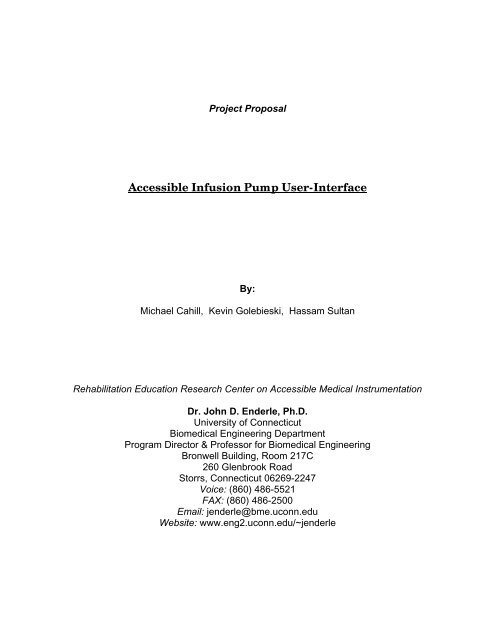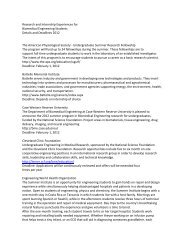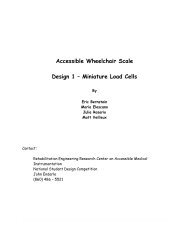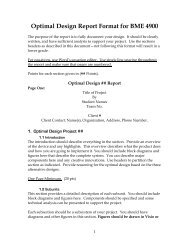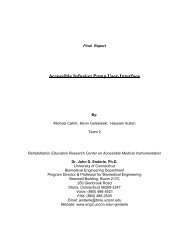Accessible Infusion Pump User-Interface - Biomedical Engineering ...
Accessible Infusion Pump User-Interface - Biomedical Engineering ...
Accessible Infusion Pump User-Interface - Biomedical Engineering ...
You also want an ePaper? Increase the reach of your titles
YUMPU automatically turns print PDFs into web optimized ePapers that Google loves.
Project Proposal<strong>Accessible</strong> <strong>Infusion</strong> <strong>Pump</strong> <strong>User</strong>-<strong>Interface</strong>By:Michael Cahill, Kevin Golebieski, Hassam SultanRehabilitation Education Research Center on <strong>Accessible</strong> Medical InstrumentationDr. John D. Enderle, Ph.D.University of Connecticut<strong>Biomedical</strong> <strong>Engineering</strong> DepartmentProgram Director & Professor for <strong>Biomedical</strong> <strong>Engineering</strong>Bronwell Building, Room 217C260 Glenbrook RoadStorrs, Connecticut 06269-2247Voice: (860) 486-5521FAX: (860) 486-2500Email: jenderle@bme.uconn.eduWebsite: www.eng2.uconn.edu/~jenderle
Executive SummaryHome infusion pumps are vital to the health and independence of manypatients. These pumps are used to deliver materials in the body fluids of patients.However, due to interfacing problems misuse leads to dosing errors risking thehealth of the patient. In reviewing works on the market, many research groupshave actively studied the inherent problems with pump interfaces. Throughusability testing and human factor studies new designs that minimized errorswere created. Patents already on the market include many design changes toinfusion pumps as complete units but few augment pumps currently in use. Thedesign will incorporate a highly visible display, auditory output, and tactilelydistinguishable input buttons. The device will be lightweight, easily portable, andbattery operated increasing patient independence. Considering our limitedbudget, purchasing a medical infusion pump would be detrimental to ourproject and limit our freedom of choosing other major components for the finaldesign. As a result, we hope to receive a donated infusion pump from a localhospital or medical business. Our current estimated price values for our designcomponents are subject to change with the progression of our project and willbe finalized upon determining the final components needed.1
Table of ContentsSectionPage Number1 Introduction -------------------------------------------- 3 - 81.1 Background ---------------------------------------- 31.2 Purpose of the Project ------------------------------- 3 - 41.3 Previous Work Done by Others ----------------------- 4 - 51.3.1 Products ------------------------------------ 5 - 61.3.2 Patent Search Results ------------------------ 7 - 82 Project Description ------------------------------------ 8 - 132.1 Objective ------------------------------------------- 8 - 92.2 Methods -------------------------------------------- 9 - 133 Budget --------------------------------------------------- 13 - 144 Conclusion ---------------------------------------------- 14 - 15References ------------------------------------------------- 162
1 Introduction1.1 BackgroundFor patients with physical limitations, infusion pumps can be difficult to operatecorrectly. Whether it is a vision problem, a hearing impairment or an ailment thatrestricts motor function, disabilities increase the risk of patient error in deviceoperation. Our visually disabled clients, Mat and Akiko, require tactile cues tobe added to the interface for proper use, along with auditory confirmation ofthe input. To cater for patients with hearing loss like Dolores there must be alarge easily viewable display. Jorge, Lakisha, Sani, and Dolores all suffer fromsome form of limited dexterity due to carpal tunnel syndrome, Parkinson’sdisease, arthritis, or partial paralysis. The buttons must be large enough toaccommodate an unsteady hand while also being easily triggered with slightpressure. Warnings from the interface will need to be communicated throughboth auditory and visual cues in order to encompass the wide variety of thepatients’ disabilities.1.2 Purpose of the ProjectWith current infusion pumps there is not appropriate feedback to the inputcontrols of the unit. This gives an opportunity for erroneous entries without anywarning. Due to these errors, over- or under-dosing may occur leading to serioushealth risks for the patient. Patients in need of an infusion pump may also havelearning disabilities or apprehension about technology. To encouragewidespread use for all patients, a simple method of operation and short learningcurve should be implemented. This would allow a patient to become moreindependent, especially if there are warnings included in the interface to limitdosing errors. Further promoting independence is a small interface that wouldensure portability and patient privacy.<strong>Infusion</strong> pumps are instrumental for patients’ very survival with errors in materialdelivery, both over- and under- dosages, carrying the risk of detrimental effectsfor the patients. Often these errors are due to misuse by patients or their caregivers, such as miscalculation of dosage levels, data entry error or titration error.<strong>User</strong>s are often physically limited by age or illness, leading to the abovementioned problem. As preliminary requirements, precautions must beadministered by the device to ensure accurate operation. Audio output fromthe device would assist users with visual impairment on confirming the correctdosages. In turn, the confirmation buttons, as well as operational buttons shouldbe easily distinguishable, both visually and tactilely, in order to prevent overandunder- dosage accidents by the visually and physically limited users.Additionally, visual displays should be considered to allow the hearing impaired3
to correctly operate the device. The design alone should be easy to learn andoperate by the patient and/or caregiver, while being aesthetically pleasing andnon-threatening to technology-impaired users. As the infusion pump should beeasily accessible, designing a portable interface is a necessity.1.3 Previous Work Done by OthersJuliana Brixey, J. Frenzel, M. Chalambaga, and Todd R. Johnson all of TheUniversity of Texas Health Science Center at Houston studied and prototyped aninterface for an infusion pump. They focused on the implementing the usability<strong>Engineering</strong> Lifecycle in which the basic requirements for an infusion pump weregathered and field testing was completed to develop the prototype. Their workwas presented during a poster session at AMIA 2002.A similar study was completed by Karin Garmer, Erik Liljegren, Anna-Lisa Osvalder and Sven Dahlman from Chalmers University of TechnologyDepartment of Human Factors <strong>Engineering</strong> in Göteborg, Sweden. This groupused a human factors approach alongside usability tests in order to design anew interface. Tests were performed with nurses from two Intensive Care Unitswith daily infusion use and a dialysis ward where infusions were rare. To create abaseline the facilities current infusion pumps were used and problems wererecorded via video-recording, think-aloud protocols, and surveys. From theseusability tests, the interface was designed and evaluated by the original testsubjects in a clinical setting. The research group found that the human factorsapproach gave them the feedback needed to make the new interface lessproblematic while the usability tests provided more specific solutions to problemsthat were identified. Their work was published in the Journal of ClinicalMonitoring and Computing in 2002.Mark J. Graham, Tate K. Kubose, and Vimla L. Patel from Columbia University’sCollege of Physicians and Surgeons, Department of <strong>Biomedical</strong> Informaticsalong with Desmond Jordan from Columbia University’s College of Physiciansand Surgeons, Department of <strong>Biomedical</strong> Informatics and Department ofAnesthesiology and both Jiajie Zhang and Todd R. Johnson from the University ofTexas Health Science Center’s School of Health Information Sciences at Houstondid research in evaluating infusion pumps in order to progress patient safety inIntensive Care Units. Since the pumps weren’t being redesigned the researcher’sgoal was to identify errors, mark their respective severity, and pass thisinformation onto the users to avoid future errors. This was accomplished througha heuristic evaluation using four raters, three with cognitive science and heuristicmethodology background and one nurse in surgical intensive care. Uponcompletion, the researchers found a few catastrophic problems including; nooverride function for air in tube failures, pressure too high to activate buttonswith a low confirmation beep that is hard to hear in working environment, and4
the pump will start even if programmed with a high volume. All of the problemswere listed and categorized in order to pass the information to the clinicalenvironment and the designers of the product. This work was published in theInternational Journal of Medical Informatics in 2004.1.3.1 ProductsThere is an extensive market for infusion pumps which is filled by many of themedical device manufactures from around the world. However, the infusionpumps are sold as stand alone units with an interface designed into the mainbody of the product. These means there aren’t any separate interfaces that aresold that plug into the units. The products below highlight the majority of thecurrent infusion pumps in the this niche of the market.Abbott – Aim Plus, Lifecare 5000 Plum and Plum XL - www.abbott.comBaxter – Colleague and FLO-GARD - www.baxter.comB Braun - Outlook Safety <strong>Infusion</strong> Systems, Vista® Basic - www.bbraunusa.com5
Cardinal Health – Alaris®, Alaris® SE pump, MedSystem III® -www.cardinalhealth.com/alaris/Curlin Medical – PainSmart, 4000 CMS, 4000 Plus, and 2000 Plus -www.curlinmedical.comSigma International – 8000 and 6000 series pumps - www.sigmapumps.comSmiths Medical - Deltec® 3000 and 3100 series pumps – No pictures available -www.smiths-medical.com6
1.3.2 Patent Search ResultsPatent research when designing a new product for market is necessary becauseof the restrictions that are placed on existing patented products. When a newpatent is issued there is a generally 20 year term that begins from the date theapplication was filed. This term gives the rights to the patentee to prohibit othersfrom “making, using, offering for sale, selling or importing the invention.” 1 Thismust be implemented by the patentee in order to have a case of patentinfringement.A search using the site http://www.uspto.gov/patft/index.html and the term‘medical infusion pump’ in the title and ‘interface’ in all fields only resulted inthree patents being found. The most relevant patent found was 5,782,805Medical infusion pump - July 21, 1998 - Meinzer , et al. This patent describes theinfusion pump as a complete unit including the main body with interface, atleast one removable pump module with IV attachment area, an auxiliarydisplay for supplemental information, and a microprocessor which provides thecalculations for the interface and pumping mechanism. Another patent in thissearch was 6,999,854 - Medical infusion pump capable of learning bolus timepatterns and providing bolus alerts - February 14, 2006 - Roth which described apump that can actively learn bolus time patterns for patients who must undergomedication injections regularly around the same time. This device is specificallygeared towards patients such as diabetics undergoing insulin injections aroundtheir eating patterns. By broadening the search term to only ‘medical infusionpump’ in the title the results jumped to seven patents which included D430,288 -Medical infusion pump - August 29, 2000 - Mason , et al. This is a design patentwhich only had ornamental pictures of the pump but it was a manuallyoperated syringe type pump that isn’t in the scope of our project as we aredesigning an electronic interface. Another result was D268,206 - Medical infusionpump - March 8, 1983 - Kosako which is also a design patent which had onlyornamental pictures including the one shown below in Figure 1.Figure 1: D268,206 - Medicalinfusion pumpBrowsing the referenced patents I came upon the term peristaltic pump which isthe common delivery method for infusion pumps due to its sanitary andmechanical benefits. Another search using the term ‘medical peristaltic pump’provided 4 patents with 4,544,336 - Medical peristaltic pump - October 1, 1985 -1 United States Patent and Trademark Officehttp://www.uspto.gov/web/offices/pac/doc/general/index.html#patent7
Faeser , et al. being the most relevant. This patent describes how the pumpsqueezes the contents through the tube via rollers mounted on a wheel.Unfortunately there was only one patent found that specifically dealt withmedical pump interfaces. This was D507832 - <strong>User</strong> interface for a medical device- July 26, 2005 - Yanniello , et al. and was found using the terms ‘infusion pump’and ‘interface’ together in all field searches. This is another design patent butunfortunately the pictures weren’t available due to an internet plug in error.There were 783 results found with this search and the other most relevant patentsinclude:5,920,477 - Human factored interface incorporating adaptive pattern recognitionbased controller apparatus - July 6, 1999 - Hoffberg , et al.This patent describes the need for a more-readily usable interface forelectronics devices but it could be implemented for a medical device.5,901,246 - Ergonomic man-machine interface incorporating adaptive patternrecognition based control system - May 4, 1999 - Hoffberg , et al.This patent explains how a programmable system can actually predict a user’sdesired inputs based on past data. This would allow the interface to slowly learnthe desired functions the user chooses most often via a closed loop feedbacksystem. This technology can also be incorporated into a medical device.5,681,285 - <strong>Infusion</strong> pump with an electronically loadable drug library and a userinterface for loading the library - October 28, 1997 - Ford , et al.This patent allows the infusion pump to be loaded with a library of drugs whichcould be selected from or added to by the user. This would allow the product tocheck for errors in entries from patients or caregivers who aren’t familiar with theinfusion pump.5,664,270 - Patient interface system - September 9, 1997 - Bell , et al.This patent deals with interfacing a multitude of medical devices into oneremote controller for ease of use. Even though the device isn’t specifically for aninfusion pump the technology for creating an easily usable interface for apatient still exists in this patent.2 Project Description2.1 ObjectiveThe objective of the project is to design a portable, steadfast, low-cost userinterface to allow easy operation of a medical infusion pump for the patientand/or caregiver, to provide accurate delivery of necessary materials (fluids,medications or nutrients) to the patient’s body. One of the major problems8
found from many medical infusion pump users is the lack of accessibility of theuser interface. In turn, this project will reduce the occurrence of over- or underdosages,data entry errors, titration errors, and greatly reduce the detrimentalhealth risks for the patient, while increasing user ease and patientindependence.The intended project design will connect to a medical infusion pump via anexternal port (i.e. serial, USB), creating a secondary user interface. This projectwill not only reduce input errors, but also allow easy navigation for patientsand/or users with physical, visual, and auditory disabilities. In response to inputsprovided by patients and/or caregivers with visual impairment, the interface willprovide an auditory output to confirm the selected options (dosage, rate,volume, etc.) to help reduce the risk of miscalculation. On top, the auditoryoutput will provide instructions to the patient and/or caregiver in pressing thecorrect buttons in response to their input selection. Confirmation buttons(ON/OFF, START, STOP, YES, NO, etc.) will be greatly distinguishable and distal inproximity relative to each other to prevent accidental problems, such as overandunder- dosage for the visually and physicallyimpaired. In addition, a visual display (i.e. LCD screen)will allow the hearing impaired to correctly operate thedevice by providing the correct values as entered onthe user interface, in addition to providing visualwarnings of possible calculation errors to prevent theaccidental confirmation of inaccurate input values.Nonetheless, the device in general will be aesthetic tothe eye and allow ease of operation for technologyimpairedusers. Patients in need of a medical infusionpump may also have learning disabilities. To encouragewidespread use for all patients, a simple method ofoperation and short learning curve will beimplemented. This would allow a patient to becomemore independent, especially if there are warningsincluded in the interface to limit dosing errors. The userinterface will be small and portable with the medicalinfusion pump to further promote independence andprivacy for the patient. Since most medical infusionpumps are positioned on a rolling stand (Figure 2), theuser interface will be placed in close proximity toprevent lose and/or damage.Figure 2 : Pedigo 1080-6<strong>Infusion</strong> <strong>Pump</strong> Stand2.2 MethodsAn accessible interface between and infusion pump and the user is intended toenhance the function of the infusion pump in two main areas. First, the9
interface is intended to increase the accessibility of the infusion pump. Byproviding augmented visual, auditory and tactile control and confirmationoptions, the market of customers is expanded while making the self operation ofan infusion pump and alternative to a home assistant for many patients.Second, the interface is to provide a level of safety against over- or underdosing.The first point of accessibility will be the visual display. In order to make thepump accessible to those with poor vision, a large, high contrast display isnecessary. The characters must be large and bright enough that those with loweyesight can read them, but the size and brightness will also be limited by otherfactors. To remain accessible, the unit must be battery powered as manyinfusion pumps are. Therefore the intensity of the screen must be limited so as togive the device a reasonable lifetime per battery charge. In the same light, thedevice must be of a reasonable size to be easily transported around the home.This will limit the size of the display. Considering that there must be enoughcharacters to convey information accurately, the size limitation on the entiredisplay translates into a size limitation on the characters themselves. The displaymust also be simple and inviting to those who do not feel comfortable operatinghigh tech equipment.To supplement the visual display for those who have low eyesight, the interfacemust also have auditory confirmations. Ideally these auditory cues will takeadvantage of speech software to convey information. For those who cannotread the screen of the device, directions for what is to be entered as well asrepetition of what has been entered will help patients will low eyesight maintaincorrect dosage levels. The control of the auditory component must beconsidered. Patients who do not need the auditory cues could becomeannoyed by their constant presence. Therefore, auditory component must beoptional. Volume control should also be an option. If the auditory settings werebuilt into the menu structure of the device, people who need the auditory cuesintermittently would have a hard time navigating the device to turn them onwhen needed. For this reason, auditory cues and the volume thereof should bephysically controlled by buttons on the outside of the unit. A single on/off togglebutton with a volume wheel would be easy and familiar to users.It is likely that some patients using this interface will be suffering from arthritis orother conditions which decrease their dexterity. For these people, as well aspatients with low eyesight, a simple and clearly distinguishable set of inputbuttons is required. These buttons must be large and distinguishable by touch.This can be accomplished either through spacing on the device or tactilesignals such as bumps in different patterns and the shape of the buttons. Thebuttons must be easy to press while at the same time offering enough resistanceto being pressed that the accidental triggering of a button is minimized.10
OKBACKOKThe layout and function of buttons should beas intuitive as possible. Much can belearned from the plethora of handheldelectronics with which people work daily.The iPod digital music player, for instance,has only five buttons in addition to a scrollwheel. The use of these buttons to navigatethe device is easily learnable. Along theselines, the number of buttons on the infusionpump interface should be kept to aminimum. Well designed functionarchitecture can reduce the number ofneeded input buttons to as few as three.Figure 3: Possible Button LayoutsTwo buttons, an up and a downbutton for instance, would bedesignated for navigation withinthe menus of the device as well asselecting digits for dosing levels. Athird button would be used toselect a highlighted function orconfirm and entry into the system.A fourth button with the functionof ‘cancel’ or ‘back’ could alsobe implemented in lieu of a‘back’ option at the bottom ofevery menu. This decision must bemade based on menu length andthe number of menus needed. Aback button, bringing the total tofour input buttons, would not overcomplicated things and maymake the device easier to use.<strong>Interface</strong>Mounting Arm<strong>Interface</strong>IV Stand<strong>Infusion</strong> <strong>Pump</strong>Figure 4: Pole-mounted <strong>Interface</strong>The necessity of accessibility putsseveral constraints on the design. Physically, the device must be relatively smalland light. Patients using infusions pumps are often elderly or weakened by theirillnesses. A device that they can maneuver around their home is needed. Inaddition to being light and small enough to be moved, the interface must alsobe mounted in a useful location. Many infusion pumps are mounted to thepoles of IV stands. This should therefore, be an option for the interface. One11
possible problem with this is that the many tubes running to and from the infusionpump itself may interfere with access to a pole-mounted interface. To workaround this, a pole mounting arm of some sort may be considered in the design(Figure 4).As most infusion pumps are battery operated, the interface should also be.Having a battery operated device places several limitations on design. Thevisual display is likely to be the main power draw, especially considering that ismust be very bright to increase visual accessibility. The screen should thereforebe efficient. An LCD would be the most power conservative. A dimming optionwill also be considered to allow for longer life if the full brightness is not requiredby the patient. A screen saver function could also be employed if a displaysuch a color LCD panel is used.For the interface to be accessible, it must be easily maintained. The batteryitself should be easily accessible and require only moderate force and dexterityto remove. The simple the battery removable, the more easily the patient canuse the device. Ideally the device would not need to be dismounted to removethe battery.As mentioned above, the second major function of the infusion pump interfaceis to ensure the patients’ safety by preventing incorrect dosing. This can beaccomplished in a variety of ways. The most basic safety feature is making surethat a dosage was not entered incorrectly. This can be done by simplyreviewing the entered data for the patient. Using both visual and auditoryinterfaces the device should recount the selected dose and schedule in orderto allow the user to catch and correct any mistake that he or she may havemade. Confirmation of the dosing should be failsafe. The user should be askeda question along the lines of “Is this correct?” with the ‘No’ answer highlighted.The patient must then select yes and confirm. This way, the patient is madeaware of what the device has received for data.A method that is even more error-free may be available. There exist barcodesystems which identify the drug name and concentration. If this system isnonproprietary, it may be possible to include a laser scanner on the interface.The patient would simply have to scan the barcode and the dose and dosingschedule would be entered into the device automatically. At the very least, thedrug name and concentration would be reported to the user so as to ensurethat the infusion pump is being loaded with the proper medication.Another way to reduce patient error is to allow dosing protocols to be saved. Ifa patient is on a standard drug regimen, there is no need to reenter the samedosing requirements every time a new vial is inserted. Allowing a protocol to besaved and reloaded will decrease the chance of high- or low-dosing.12
As the device is to be battery operated, a low battery warning is essential. Thewarning must be both visual and auditory. The warning should begin on aregular basis an adequate period of time before operation ceases. The lengthof this warning will be determined based on the battery life of the interface.The interface is designed to make the infusion pump more accessible.Therefore, all warning and messages sent by the infusion pump must bepresented through the interface in order to ensure that the patient canperceive the information. This includes all warnings, such as open doors,occlusion, check injector, check syringe, and so on. If possible, furtherinstructions for dealing with the errors can be given, but this is unlikely as thereare many different infusion pumps available and they all operate differently.The connection with the infusion pump itself may prove to be haphazard. It isunlikely that infusion pumps come with serial bus ports. If this is found to be thecase, interfacing between the devices will be done along these lines. However,there is a possibility that the interface will need to be wired into the pump. If thisis found to be the case, releasable connectors will be used to allow the devicesto be separate in the event of failure or transport.3 BudgetThe budget for this design project is currently under revision and preciseamounts will be determined near the beginning of next year when the finaldesign is set and the ordering of the device components are planned.Nonetheless, preliminary components have been established for theconsideration of the infusion pump user interface, shown in Table 1.The retail market values and estimated price for the device components are ofrough estimate and are subject to change during the progression of establishingthe final outline for the infusion pump user interface.The purchase of a new medical infusion pump would greatly deplete ourbudget of $2000, which in turn will limit our freedom of purchasing other devicecomponents. As a result, we hope to receive a medical infusion pump donatedfrom a local hospital or medical business to help us assist in designing acommunication pathway between the pump and the secondary user interfaceto initiate our design outline for the project.13
ItemRetail Value inMarketEstimated BuyingPrice for ProjectMedical <strong>Infusion</strong> <strong>Pump</strong> $1000 - $5,500 $0LCD Display <strong>Interface</strong> $100 - $1000 $200 - $400Voice Hardware $20 - $400 $100Software Components $200 - $800 $100 - $300Electrical Components $200 - $600 $100 - $400Miscellaneous $100 - $200 $100 - $200Estimated Total $1620 - $8500 $600 - $1400Table 1: Estimated Budget for <strong>Accessible</strong> <strong>Infusion</strong> <strong>Pump</strong> <strong>User</strong>-<strong>Interface</strong>The various components (LCD display interface, Voice hardware, software,electronics) for the interface range greatly in price; buying the cheapestcomponent may be helpful in reducing costs and expenditures for the budget;nonetheless, high quality for the end product is greatly desired. As pricecorrelates proportionally with quality, finalizing the components upon orderingwill be greatly considered.4 ConclusionFor patients with physical limitations, medical infusion pumps can be difficult tooperate correctly. Whether it is a vision problem or an ailment that restrictsmotor function, there is always a risk of delivering the wrong dosages. Withcurrent medical infusion pumps there is no appropriate feedback to the inputcontrols of the unit. This gives an opportunity for errors to be entered into thesystem without any warning. Once this phase of the patients’ interaction withthe pump has passed, over- or under- dosing may occur leading to serioushealth risks for the patient.This project’s intended design approach will greatly reduce the patients’ healthrisk. By designing tactile cues, users with motor disabilities will not have great of aproblem using the interface compared to using a regular infusion pump14
interface. Vocal commands will be incorporated into the design to allow easynavigation for users with visual impairment. In addition, a visual display will beplaced on the design to assist users with auditory impairment, and provide as asafeguard in displaying accurate input values the user requires. Learning easewill be another feature provided by the design to allow easy navigation bynumerous users, especially the technology impaired. The design of the devicewill be aesthetic to the eye allowing comfort to all users. None of theaforementioned characteristics are found in modern medical infusion pumps,making this design project quite unique and worth the venture.Introducing the final accessible infusion pump user interface device into theindustrial market will greatly increase its desire from biomedical corporations.Considering majority of infusion pump users find difficulty using the pumpinterface, in addition to the device’s low budget cost, biomedical corporationswould be steadfast in implementing this device with their medical infusionpumps. Consecutively, the companies will gain great credibility in achieving amore reliable, cost-effective medical infusion pump for their patients and/orcaregivers. Considering the importance of the home infusion pumps to patienthealth, the need for an accessible interface is paramount.15
ReferencesBrixey, Juliana. "AMIA 2002 Symposium ." Redesign and Prototype for the<strong>Interface</strong> of a Volumetric <strong>Infusion</strong> <strong>Pump</strong> Following the Usability <strong>Engineering</strong>Lifecycle 12 Nov 2002 01 Oct 2006.Garmer, Karin, Erik Liljegren, Anna-Lisa Osvalder, and Sven Dahlman. "Arguing forthe Need of Triangulation and Iteration when Designing MedicalEquipment." Journal of Clinical Monitoring and Computing Feb 2002 105-114. 01 Oct 2006 ."General Information Concerning Patents." United States Patent and TrademarkOffice. Jan2005. 2 Oct 2006.Graham, Mark, Tate K. Kubose, Desmond Jordan, Jiajie Zhang, and Todd R.Johnson. "Heuristic evaluation of infusion pumps: implications for patientsafety in Intensive Care Units." International Journal of Medical InformaticsNov 2004 771-779. 01 Oct 2006 .16
1.)http://www.amia.org/meetings/f02/2002online/S64.HTMTitle Redesign and Prototype for the <strong>Interface</strong> of a Volumetric <strong>Infusion</strong> <strong>Pump</strong> Followingthe Usability <strong>Engineering</strong> Lifecycle Participants Ms. Juliana Brixey, MSN, MPH, RNUniversity of Texas Health Science Center at Houston University of Texas HealthScience Center at Houston J. Frenzel, MD, University of Texas Health Science Centerat Houston, Houston, TX M. Chalambaga, MCP, University of Texas Health ScienceCenter at Houston, Houston, TX T.R. Johnson, PhD, University of Texas HealthScience Center at Houston, Houston, TX Abstract The object of this project was toredesign and prototype an interface for a volumetric infusion pump following theusability engineering life cycle. Healthcare has been slow to follow the lead of otherhigh-risk industries in applying usability engineering and human factors principles toerror reduction. The U. S. Food and Drug Administration-Center for Device andRadiological Health (CDRH) acknowledges that a lack of attention to human factorsduring product design may result in a biomedical device ill suited to use in a criticalenvironment. This study utilized several usability techniques to develop a prototypeinterface for field-testing. Findings from the field tests led to refinements in the infusionpump interface. KeywordsHuman factors and user interfaces Technology assessment Quality assessmentand improvement Outcomes assessmentBrixey, Juliana. "AMIA 2002 Symposium ." Redesign and Prototype for the <strong>Interface</strong> ofa Volumetric <strong>Infusion</strong> <strong>Pump</strong> Following the Usability <strong>Engineering</strong> Lifecycle 12 Nov2002 01 Oct 2006 .2.)http://www.springerlink.com/content/edk88ghwuhunfuvu/http://www.springerlink.com/content/edk88ghwuhunfuvu/fulltext.pdfArguing for the Need of Triangulation and Iteration when Designing Add to markedMedical EquipmentitemsJournal Journal of Clinical Monitoring and ComputingAdd to shoppingPublisher Springer NetherlandscartISSN 1387-1307 (Print) 1573-2614 (Online)Add to savedSubject MedicineitemsIssue Volume 17, Number 2 / February, 2002Recommend thisDOI 10.1023/A:1016310230729articlePages 105-114Online Date Wednesday, November 03, 2004Arguing for the Need of Triangulation and Iteration when Designing Medical Equipment17
Karin Garmer 1 , Erik Liljegren 1 , Anna-Lisa Osvalder 1 and Sven Dahlman 1(1) Department of Human Factors <strong>Engineering</strong>, Chalmers University of Technology,Göteborg, SwedenAbstract Objective.There is a need to develop adequate methods for useby themanufacturers of medical equipment when specifying requirementsfor theirdevelopment and in order for hospitals to critically assesstheir usability qualities beforepurchase. A Human Factors approach wasused to determine requirements for theredesign of an existingvolumetric infusion pump. With these requirements as a startingpoint, anew user interface for an infusion pump was designed. Usability testswerecarried out to verify whether the new interface had betterusability than the existinginterface or whether further improvementswere needed. This paper has two aims: 1) tocompare the nature of therequirements derived from a Human Factors approach andfrom usabilitytests and 2) to evaluate the use of usability tests on existingmedicalequipment as a basis for redesign and for evaluating the redesign.Method.Theuser requirements derived from the Human Factorsapproach were compared with theuser requirements derived from theusability tests.Results.The results show that therequirementsderived from the Human Factors approach adequately coveredcontextualaspects of use. However, to derive requirements for a specificandoperational level, usability tests must be conducted on existingequipment andprototypes. This study indicates that usability tests onexisting medical equipment as abasis for redesign give a betterunderstanding of problems with existing equipment.Moreover it isimportant to carry out usability tests to evaluate a redesign and findasatisfying solution. Expert users of the equipment had the experience,competenceand confidence to be critical and suggest improvements basedon their practicalknowledge. The novice users on the other hand wereimportant test users as theyuncovered most of the serious handlingproblems and also committed most errors.Conclusion.Therequirements derived from the Human Factors approach and theusabilitytests are important for the development of a new and improved userinterface.The requirements derived from the Human Factors approach canbe attributed tocontextual requirements. The requirements derived fromthe usability tests have ahigher degree of concreteness, are morespecific and focus more on design solutionscompared to the requirementsderived from the Human Factors approach. It isimportant to considerintended user groups when carrying out usability tests, as thenature ofthe information from the different groups can be different.Garmer, Karin, Erik Liljegren, Anna-Lisa Osvalder, and Sven Dahlman. "Arguing for theNeed of Triangulation and Iteration when Designing Medical Equipment." Journalof Clinical Monitoring and Computing Feb 2002 105-114. 01 Oct 2006 .3.) Heuristic evaluation of infusion pumps: implications for patient safety inIntensive Care Unitshttp://www.sciencedirect.com/science?_ob=ArticleURL&_udi=B6T7S-4DFNFCM-3&_coverDate=11%2F01%2F2004&_alid=459109074&_rdoc=1&_fmt=&_orig=search&18
_qd=1&_cdi=5066&_sort=d&view=c&_acct=C000036298&_version=1&_urlVersion=0&_userid=669286&md5=074273b2076eb13615859876b9436138Graham, Mark, Tate K. Kubose, Desmond Jordan, Jiajie Zhang, and Todd R. Johnson."Heuristic evaluation of infusion pumps: implications for patient safety in IntensiveCare Units." International Journal of Medical Informatics Nov 2004 771-779. 01Oct 2006 .4.) http://www.npsf.org/biblio/codesHMIr.htmNational patient safety foundationhuman machine interfacing5.) http://www.iec.org/online/tutorials/hmi/topic06.html"General Information Concerning Patents." United States Patent and Trademark Office.Jan2005. 2 Oct 2006.MedicalSimilar problems have occurred related to FDA’s recallof eight Colleaguemodels of the medical infusion pump (Figure )manufactured byBaxter Healthcare Corporation issued in July 19 2005.The devices havebeen known to have flaws in their user interface. As aresult, the devicewould allow the user to accidentally turn off themedical infusion pumpwhen planning to begin infusion. As shown in figure 1, the ON/OFF button of the medical infusionpump is in close proximity to the START button, thus allowing the accidental powering-off of thedevice. Such defects can be life-threating to patients and/or users with visual and/or physicaldisabilities. About nine people have been seriously injured or killed due to the medical infusionpump defects.Current commercial infusion pumps from companies such as Alaris Medical Systems (Figure 1), Baxter,Baxa Corporation, and B. Braun (Figure 2),such improvements (mentioned above) for the acoustically, visually, and physicallyimpaired would greatly enhance the marketing of their products for home infusion pumps and greatlydecrease errors in drug/nutrient delivery.http://www.onlinelawyersource.com/infusion_pump/medical_infusion_pump.html19


